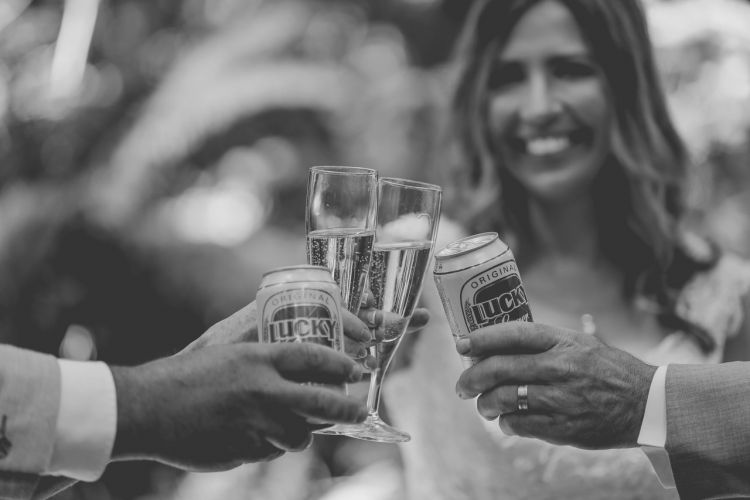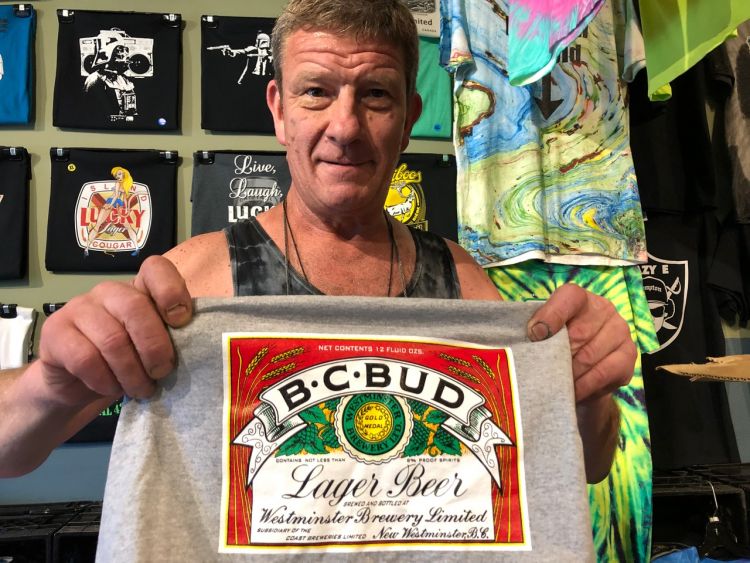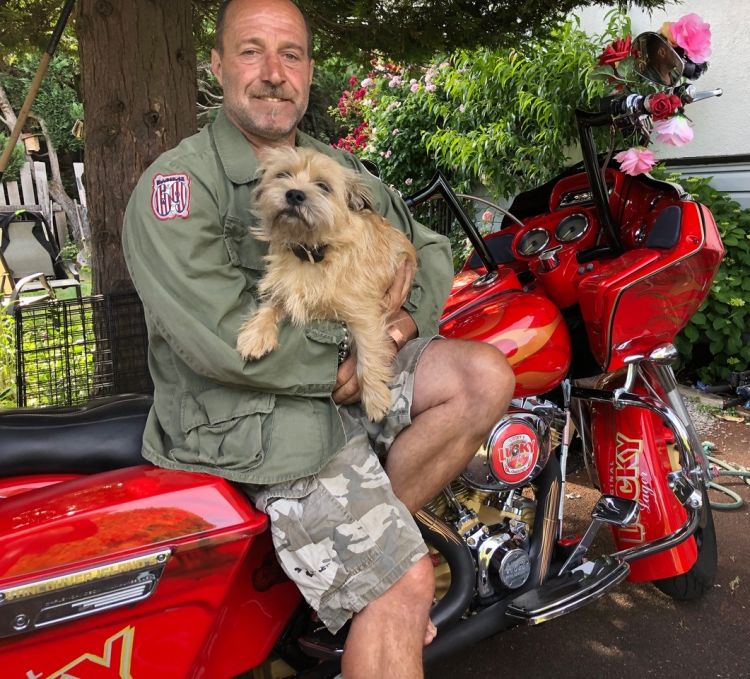
Lucky Lager: the Island’s working-class beer thrives despite craft craze
Guest contributor Larry Pynn is a longtime Vancouver Sun writer who became intrigued by Vancouver Island’s culture of Lucky Lager upon retiring to the Cowichan Valley. Here’s his look at a beer that’s special to an entire region of BC.
Image: Susan Fox and Paul Wagner at home.
Photos by Larry Pynn unless otherwise indicated
Paul Wagner and Susan Fox are Lucky in love. On their first date six years ago, they drove to the forested outskirts of Port Alberni in winter and cozied up to a roaring campfire. Then Fox opened a carefully-prepared picnic lunch that included two of Wagner’s favourites — smoked sausages from Pete’s Mountain Meats and Lucky Lager beer. It was love at first sip. “I was fussing about what to impress this man with,” she recalls. “I barely knew him.”
Wagner, a heavy-equipment operator in the forest industry, had no time to go home and freshen up. “I was late, stuck at work. I showed up in my work clothes and my work truck.” That suited Fox, a project manager, just fine. “I immediately felt comfortable. We didn’t have to go through that fake stage. The perfect date.”
Wagner enjoys the taste of Lucky — “It’s got a little bit of bite to it, which I like, and it’s refreshing” — but there’s something bigger going on. “It’s almost like you get brainwashed. I don’t even look at other beer.” Wagner is not keen on hoppy beers and mischievously dismisses the craft-beer crowd as “toques and beards. They have work boots on but have never done a day of work.”
Vancouver Island is Lucky Lager country, has been for generations. Nowhere in Canada is the brand so popular, bucking craft trends to remain the working person’s beer of choice and achieving cult-like status in rural, resource-dependent communities.
Netty Schmuland, lessee of the Lucky Logger Pub in the small North Island timber town of Woss, reckons 99% of her beer sales are Lucky Lager, with loggers and tourists her clientele. The other one per cent? Fancy beers such as Corona and Stella Artois. “Lucky is what people want,” she continues. “I think it’s nostalgia, the fact that it was brewed on the Island….”
Does she drink it? “Absolutely not. I’m not a beer drinker, but it definitely has a different smell … versus the airiness of a Budweiser.”
You can’t get Lucky on tap at her pub, to customers’ chagrin. She says the bar equipment was in such bad shape when she took over the business a year ago that she’s been forced to sell only bottled beer from a fridge.
Schmuland is correct that Lucky was once brewed on the Island, but the history dates back much further. According to self-described “breweriana collector and brewery historian” Gary Flynn, of Bellingham, Washington, the first Lucky Lager brewery was established by the General Brewing Corporation of San Francisco but was controlled by Coast Breweries Ltd. of British Columbia. “After WWII, Lucky Lager became the best-selling beer in California….” Flynn writes. The first beer hit the market in 1934.

Lucky Lager: a tradition for countless Islanders. Photo: Andrea Anderson
The Royal B.C. Museum archives explains further that Coast Breweries Ltd. was a consortium founded to hold the assets of several B.C. breweries. American breweries came on board from 1934 to 1949, including the General Brewing Company. By 1954, the consortium had been renamed Lucky Lager Breweries Limited and three years later was purchased by Labatt Breweries.
Labatt did brew Lucky Lager on Vancouver Island until it closed its Victoria brewery in 1982. Today, Labatt is owned by the multinational giant, AB InBev, which produces major brands such as Budweiser, Corona, and Stella Artois. Lucky Lager is currently brewed in Edmonton, Alberta.
While U.S. sales of Lucky Lager fizzled out over time, there’s been a recent resurgence in the beer’s historic home base of San Francisco. Pabst Brewing Company, owner of the Lucky Lager brand in the U.S., has worked with San Leandro-based 21st Amendment Brewery to produce a 4.2-per-cent-alcohol beer.
The product has been radically updated. Five different can designs present the word Lucky in languages heard every day on the streets of San Francisco, including English, Chinese, Spanish, Korean and Vietnamese. The beer is described as an unfiltered lager that “pours with a pale straw color and a clean white head, with the aroma of sweet corn, toasted bread and light notes of citrus fruits from delicate hops.”
The U.S. version of Lucky Lager is brewed exclusively for the Bay Area, whereas the version sold in Canada can be found pretty much everywhere on Vancouver Island. The Growler, a B.C. craft-beer guide, puts it this way: “In just about every fridge, the back of every pickup truck, and the bottom of every roadside ditch, you will find cans of Lucky Lager. It’s as Vancouver Island as Nanaimo bars and driving 10 km/h under the speed limit.”
In an article entitled “Local, Not Lucky: Friends don’t let friends drink foreign-owned macro swill”, The Growler observed that “There is nothing remotely Vancouver Island about this beer: not its owners, its makers, or even its ingredients. Yet the locals claim it as their own.” Canadians’ enthusiasm for Tim Hortons didn’t wane after the fast-food chain was purchased by Burger King in 2014, so why should Lucky Lager be any different? Still, newcomers can be shocked at the level of Lucky devotion on Vancouver Island.
Michael Cahan worked 15 years with BC Liquor Stores in the Lower Mainland before moving to Vancouver Island, where he served as manager of the Port Alberni store for 20 years, retiring in 2017. “I was gobsmacked to see the pallet bays full of Lucky instead of other brands more popular in Vancouver,” he recalls. “Port Alberni hunters used to complain bitterly when they went moose hunting in northern B.C. They couldn’t get any Lucky. The stores up there finally learned to bring in Lucky for hunting season. That’s what I’ve been told.”

Pallets of Lucky are de rigueur all over the Mid- and North Island
Cahan described old-timers coming into the liquor store and lamenting that Lucky used to be eight-per-cent alcohol by volume compared with the current five per cent. He eventually found an old bottle of Lucky that read eight-per-cent proof, which equates to four-per-cent alcohol, meaning that the older version actually had less punch.
Cahan understands why the brand resonates with loggers, serving to wash the dust down throats at the end of a hard day in the woods. “You want to be that lucky logger who doesn’t have a tree fall on you,” he adds. While Cahan remains fascinated by the Lucky culture, you won’t catch him drinking it. “I’ve had a sip of Lucky, but it didn’t leave me with a favourable impression.”
Lucky is clearly good for business, and not just in retail beer sales. At Whiskey Creek on Highway 4 near Parksville, a T-shirt shop screams at motorists to pull in for a closer look. The quirky Bill Bokstrom, owner of T-shirts That Talk, sells Lucky T-shirts, tank tops, hoodies, hats, toques, jogging pants, booty shorts, and on and on. “That’s all they want; it pays the bills,” he explains.
One T-shirt depicts the late legendary guitarist Jimi Hendrix holding a Lucky can. “People think we photoshopped that, but that’s a real photo, not altered at all. That’s an American tall can he’s drinking. He was in a crowd after a show, kind of being interviewed. I thought, ‘what the heck?’ He’s smiling. He likes it.” Bokstrom cannot say the same. The label on one bottle shows that Lucky received four consecutive awards in European beer competitions in the 1950s. “They must have lost the recipe somewhere along the way,” he quips. “It’s horrible stuff.”
He also holds up a T-shirt of an old Coast Breweries “bootleg” beer, BC Bud, a reference not to today’s pot culture, but a Budweiser knockoff brewed in New Westminster. “They didn’t know what they were suggesting,” says Bokstrom, adding that Budweiser eventually launched a lawsuit and won. “Kids nowadays would get a kick out of that.”
When I mention I’m writing an article, Bokstrom immediately tells me to “watch the shop” while he drives across the road to gather up Lucky collectibles from his house. He returns with a box full items such as old bottles and cans and even a couple of nickel-plated beer openers from Coast Breweries.
Bokstrom believes that another reason for Lucky’s success over the years has been its price, “marginally cheaper” than other brands. Even today, BC Liquor Stores sells a 24-pack of 355-ml Lucky Lager cans for $35.79, $2 less than Budweiser’s $37.49
The B.C. Liquor Distribution Branch refuses to release numbers on beer sales per brand on Vancouver Island, but spokeswoman Viviana Zanocco became a little wistful during our conversation. “Lucky Lager, you know that was the first beer I ever had. My dad would mow the lawn and I’d rake and he’d give me like a finger-pour in a glass. We were up in Queensborough, in New Westminster.”
The Province newspaper offered some insight to sales, reporting: “In 2015, cans of Labatt Lucky Lager outsold all other alcoholic beverages, from wines through spirits, in Nanaimo. All told, Nanaimoites bought 72,822 litres of Lucky, out-selling Nanaimo’s next favourite brew, Labatt Budweiser, by more than 6,700 litres.”
In Nanaimo, a biker has found a way to turn Lucky pride into donations for causes such as breast and prostate cancer, suicide awareness and autism. Al Kenesky reckons he’s spent close to $10,000 on a custom Lucky Lager paint job on his 2005 Harley-Davidson Road Glide. Look closely and you’ll see Lucky beer caps and iconic Island images such as a bear with salmon, killer whales, the B.C. legislature, Tofino surfers, the Nanaimo bathtub race, and so on. When strangers inevitably walk up to the bike to take a photo, Kenesky charges them $2 apiece. He figures he’s raised more than $40,000 to date. “I don’t promote Lucky, don’t try to sell it,” he insists. “I use its appeal to raise money. I consider it Vancouver Island’s bike. Pictures of this bike are plastered all over the world.” He adds: “Lucky doesn’t have an advertising budget. It sells itself, Number 1 on Vancouver Island.”
Back in Port Alberni, Wagner and Fox married in a small ceremony last year, with a barbecue reception featuring Lucky-themed T-shirts and a beer-filled canoe. Their friends, David and Andrea Wiwchar, toasted them with champagne glasses and cans of Lucky, and tied a string of Lucky empties to the back of their rental 2017 Ford 150 pickup truck.
Ultimately, Fox found something in Wagner that she finds in Lucky. On its labelling, the beer draws upon time-honoured manly pursuits: outdoor hockey, sport fishing for salmon, that sort of thing. “It’s that old-school kind of character, the way things used to be,” Fox concludes. “One of the things that really attracts me to Paul is his character. He’s got those old-school traits — hard work, respect, and that’s something.”
A Lucky man, indeed.





Last time we did the tour at Columbia Brewery in Creston they were still producing Lucky Lager in cans. In the Facebook page there is evidence that they still produce it https://www.facebook.com/pages/Columbia-Brewery-Creston-BC-Kokanee-Tour/251658338289077
Ya I and family members have been drinking lucky and lucky extra for years one time took over 300 dollars in emptys in 6 weeks now have been getting discouraged about not being able to get 15s of the extra which is are favorite in saskatoon sask and have gotten skunky lucky several times